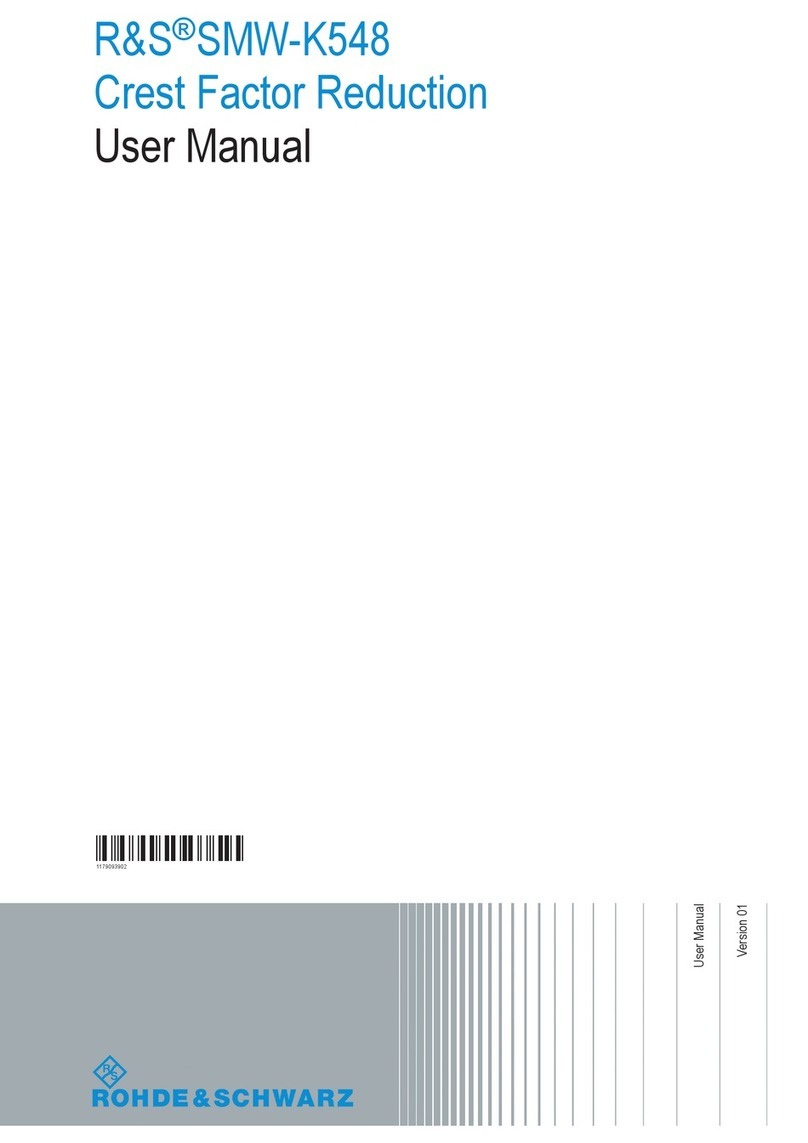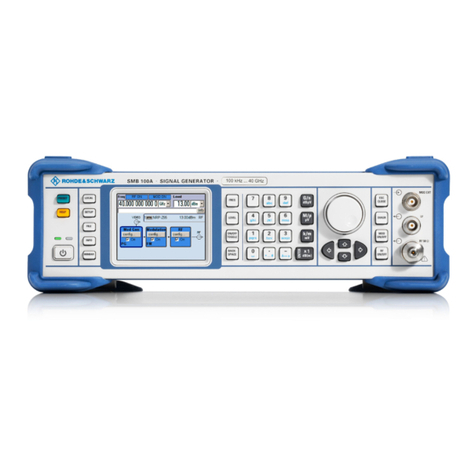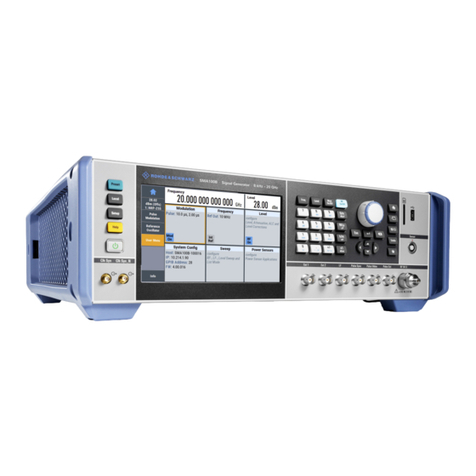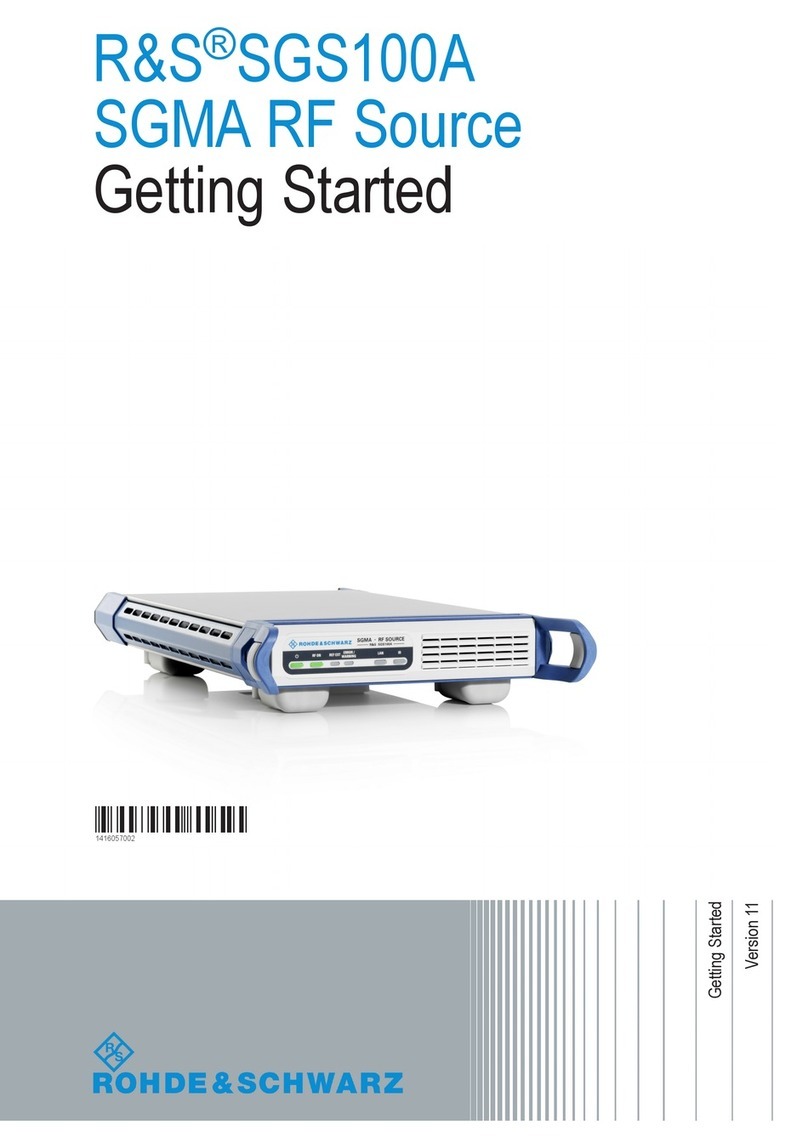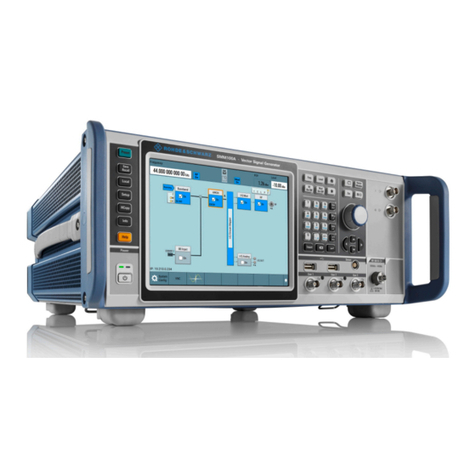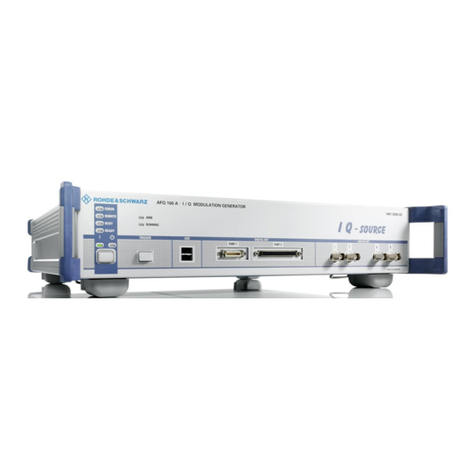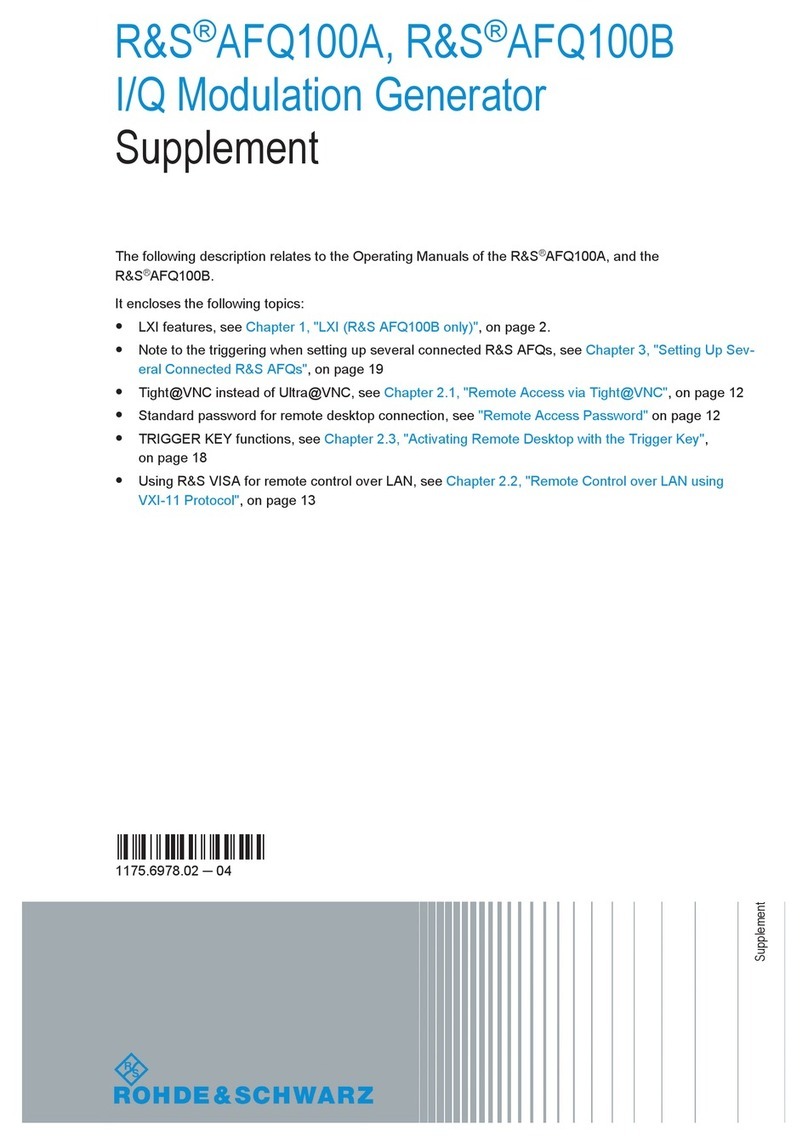R&S SGU100A User manual

R&S®SGU100A
SGMA Upconverter
Getting Started
Getting Started
Version 08
1418207002
(>BDÔ2)

This document describes the R&S®SGU100A, stock no. 1418.2005.02 and its
options.
© 2018 Rohde & Schwarz GmbH & Co. KG
Mühldorfstr. 15, 81671 München, Germany
Phone: +49 89 41 29 - 0
Fax: +49 89 41 29 12 164
Email: [email protected]
Internet: www.rohde-schwarz.com
Subject to change – Data without tolerance limits is not binding.
R&S® is a registered trademark of Rohde & Schwarz GmbH & Co. KG.
Trade names are trademarks of the owners.
1418.2070.02 | Version 08 | R&S®SGU100A
The following abbreviations are used throughout this manual: R&S®SGU100A is abbreviated as
R&S SGU, R&S®SGS100A is abbreviated as R&S SGS, R&S®SGMA-GUI is abbreviated as R&S SGMA-
GUI.

1171.1307.42 - 05
1
Safety Instructions
Instrucciones de seguridad
Sicherheitshinweise
Consignes de sécurité
Risk of injury and instrument damage
The instrument must be used in an appropriate manner to prevent
electric shock, fire,
personal injury or instrument damage.
●
Do not open the instrument casing.
●
Read and observe the "Basic Safety Instructions" delivered as
printed brochure with the instrument.
●
Read and observe the safety instructions in the following sections.
Note that the data sheet may specify additional operating conditions.
●
Keep the "Basic Safety Instructions" and the product documentation
in a safe place and pass them on to the subsequent users.
Riesgo de lesiones y daños en el instrumento
El instrumento se debe usar de manera adecuada para p
revenir
descargas eléctricas, incendios, lesiones o daños materiales.
●
No abrir la carcasa del instrumento.
●
Lea y cumpla las "Instrucciones de seguridad elementales"
suministradas con el instrumento como folleto impreso.
●
Lea y cumpla las instrucciones de seguridad incluidas en las
siguientes secciones. Se debe tener en cuenta que las
especificaciones técnicas pueden contener condiciones adicionales
para su uso.
●
Guarde bien las instrucciones de seguridad elementales, así como
la documentación del producto, y entréguelas a usuarios
posteriores.

1171.1307.42 - 05
2
Gefahr von Verletzungen und Schäden am Gerät
Betreiben Sie das Gerät immer ordnungsgemäß, um elektrischen
Schlag, Brand, Verletzungen von Personen oder Geräteschäden zu
verhindern.
●
Öffnen Sie das Gerätegehäuse nicht.
●
Lesen und beachten Sie die "Grundlegenden Sicherheitshinweise",
die als gedruckte Broschüre dem Gerät beiliegen.
●
Lesen und beachten Sie die Sicherheitshinweise in den folgenden
Abschnitten; möglicherweise enthält das Datenblatt weitere
Hinweise zu speziellen Betriebsbedingungen.
●
Bewahren Sie die "Grundlegenden Sicherheitshinweise" und die
Produktdokumentation gut auf und geben Sie diese an weitere
Benutzer des Produkts weiter.
Risque de blessures et d'endommagement de l'appareil
L'ap
pareil doit être utilisé conformément aux prescriptions afin d'éviter
les électrocutions, incendies, dommages corporels et matériels.
●
N'ouvrez pas le boîtier de l'appareil.
●
Lisez et respectez les "consignes de sécurité fondamentales"
fournies avec l’appareil sous forme de brochure imprimée.
●
Lisez et respectez les instructions de sécurité dans les sections
suivantes. Il ne faut pas oublier que la fiche technique peut indiquer
des conditions d’exploitation supplémentaires.
●
Gardez les consignes de sécurité fondamentales et la
documentation produit dans un lieu sûr et transmettez ces
documents aux autres utilisateurs.

Contents
R&S®SGU100A
3Getting Started 1418.2070.02 ─ 08
Contents
1 Preface....................................................................................7
1.1 Key Features......................................................................................... 7
1.2 Documentation Overview.....................................................................7
1.2.1 Getting Started Manual........................................................................... 7
1.2.2 User Manual and Help............................................................................ 8
1.2.3 Service Manual....................................................................................... 8
1.2.4 Instrument Security Procedures..............................................................8
1.2.5 Basic Safety Instructions.........................................................................8
1.2.6 Data Sheets and Brochures....................................................................9
1.2.7 Release Notes and Open Source Acknowledgment (OSA)....................9
1.2.8 Application Notes, Application Cards, White Papers, etc....................... 9
1.3 Typographical Conventions................................................................. 9
2 Preparing for Use.................................................................11
2.1 Putting into Operation........................................................................ 11
2.1.1 EMI Suppression...................................................................................12
2.1.2 Unpacking and Checking the Instrument.............................................. 13
2.1.3 Accessory List.......................................................................................13
2.1.4 Placing or Mounting the Instrument...................................................... 13
2.1.5 Switching the Instrument On and Off.................................................... 15
2.1.6 Function Check..................................................................................... 17
2.1.7 Default Settings.....................................................................................17
2.2 Linux Operating System.....................................................................18
2.3 Connecting an External PC and Devices..........................................18
2.3.1 Installing the R&S SGMA-GUI Software............................................... 19
2.3.2 Connecting a Remote PC via LAN........................................................20

Contents
R&S®SGU100A
4Getting Started 1418.2070.02 ─ 08
2.3.2.1 Connecting the Instrument to the Network............................................21
2.3.2.2 Assigning the IP Address......................................................................22
2.3.2.3 Automatically Adding Instruments to the SGMA-GUI .......................... 24
2.3.3 Connecting a Controller via PCI Express..............................................24
2.3.4 Connecting a Controller or a USB Device via USB...............................25
3 Instrument Tour................................................................... 28
3.1 Front Panel Tour..................................................................................28
3.2 Rear Panel Tour...................................................................................30
4 First Steps with the Instrument.......................................... 34
4.1 R&S SGU as an Extension to the R&S SGS..................................... 34
4.2 R&S SGU as a Standalone Upconverter........................................... 39
5 Instrument Control.............................................................. 43
5.1 Manual Operation via R&S SGMA-GUI..............................................43
5.1.1 Introduction to the User Interface..........................................................43
5.1.2 How to Use the Help System................................................................ 44
5.2 Network and Remote Control Operation.......................................... 46
5.2.1 Remote Control Interfaces and Protocols............................................. 46
5.2.1.1 LAN Interface........................................................................................ 47
VISA Resource Strings......................................................................... 48
HiSLIP Protocol.....................................................................................49
VXI-11 Protocol..................................................................................... 50
Socket Communication......................................................................... 50
5.2.1.2 USB Interface........................................................................................51
5.2.1.3 PCI Express Interface........................................................................... 51

Contents
R&S®SGU100A
5Getting Started 1418.2070.02 ─ 08
5.2.1.4 GPIB Interface (IEC/IEEE Bus Interface)..............................................52
5.2.2 Example: Remote Control over LAN Using the VXI-11 Protocol...........53
Index..................................................................................... 57

Contents
R&S®SGU100A
6Getting Started 1418.2070.02 ─ 08

Preface
R&S®SGU100A
7Getting Started 1418.2070.02 ─ 08
1 Preface
The R&S SGU is an upconverter in the frequency range of 10 MHz to 40 GHz.
Optimized for use in automated test equipment (ATE), the instrument offers fast
settling times in an exceptionally small form factor and low power consumption.
The R&S SGU has LO connectors for coupling multiple generators to a common
LO source and can be equipped with a mechanical step attenuator.
1.1 Key Features
The key features of the R&S SGU include the following:
●Compact size and low power consumption
●Remote connection via PCI Express, minimizing the setup time
Alternatively, LAN or USB connections available
●Coherent LO input and output connectors, also usable as MIMO input/output
and phase coherent I/Q demodulation
●Linux operating system
●Graphical user interface R&S SGMA-GUI to set up and control one or more
R&S SGU instruments simultaneously from one remote computer, available
for Windows and Linux systems
1.2 Documentation Overview
This section provides an overview of the R&S SGU user documentation. Unless
specified otherwise, you find the documents on the R&S SGU product page at:
www.rohde-schwarz.com/manual/sgu100a
1.2.1 Getting Started Manual
Introduces the R&S SGU and describes how to set up and start working with the
product. Includes basic operations, typical measurement examples, and general
Documentation Overview

Preface
R&S®SGU100A
8Getting Started 1418.2070.02 ─ 08
information, e.g. safety instructions, etc. A printed version is delivered with the
instrument.
1.2.2 User Manual and Help
Contains the description of all instrument modes and functions. It also provides
an introduction to remote control, a complete description of the remote control
commands with programming examples, and information on maintenance, instru-
ment interfaces and error messages. Includes the contents of the getting started
manual.
The contents of the user manuals are available as help in the R&S SGU. The
help offers quick, context-sensitive access to the complete information.
All user manuals are also available for download or for immediate display on the
Internet.
1.2.3 Service Manual
Describes the performance test for checking the rated specifications, module
replacement and repair, firmware update, troubleshooting and fault elimination,
and contains mechanical drawings and spare part lists.
The service manual is available for registered users on the global
Rohde & Schwarz information system (GLORIS, https://gloris.rohde-
schwarz.com).
1.2.4 Instrument Security Procedures
Deals with security issues when working with the R&S SGU in secure areas. It is
available for download on the Internet.
1.2.5 Basic Safety Instructions
Contains safety instructions, operating conditions and further important informa-
tion. The printed document is delivered with the instrument.
Documentation Overview
Table of contents
Other R&S Inverter manuals
Popular Inverter manuals by other brands

BARRON
BARRON EXITRONIX Tucson Micro Series installation instructions

Baumer
Baumer HUBNER TDP 0,2 Series Mounting and operating instructions

electroil
electroil ITTPD11W-RS-BC Operation and Maintenance Handbook

Silicon Solar
Silicon Solar TPS555-1230 instruction manual

Mission Critical
Mission Critical Xantrex Freedom SW-RVC owner's guide

HP
HP 3312A Operating and service manual
